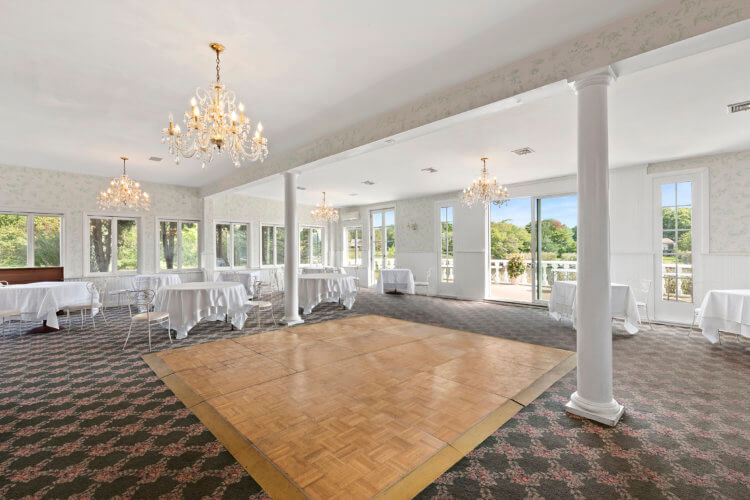Casa Basso, a Westhampton restaurant known not only for its longstanding Italian menu, but also for the 100-year-old castle and two towering sculptures of musketeers that also sit on the Montauk Highway property, was officially listed for sale on Thursday.
Enzo Morabito of Douglas Elliman Real Estate has the listing for $6.5 million.
Bejto Bracovic and his wife, Zyli Bracovic, whom most know as Julie, have been the owners since 1986. They are only the third owners since the restaurant was established in 1928.
“For me, when I bought it, it was a dream. I never thought I would be able to buy it,” says Bracovic who started out as a dishwasher at Casa Basso 50 years ago. His story is the true American Dream. “That’s why I think I deserve to relax. Since I was 12 years old, I never stopped working,” the 67-year-old says.

The Bracovics own not only a beloved Westhampton restaurant — which they have no plans to close while they look for a buyer — but also a piece of history, and a unique one at that.
Theophilus Brouwer, a sculptor, potter and inventor, built the castle himself in 1904 to resemble one he remembered near Seville from his travels in Spain, and named it Castle Inn.
Brouwer was known for his unique technique, firing iridescent pottery that was coated with transparent glaze and baked. Tiffany & Co. carried his bronze Hampton Ware. He became one of the country’s top potters and his work is considered quite valuable even today.
He relocated his factory, Brouwer Pottery, to Westhampton in 1902-1903, to a small building off to the side of the castle. In fact, when Angelina “Mamma” Basso and Louis Basso bought the building three decades later, according to Meredith Medina Murray who wrote a book, Around Westhampton, the kiln sat in the middle of what is now the dining room. Sitting in the dining room on Wednesday afternoon, Bracovic points to the fireplace and the decorative wall above it. “This was his studio,” he says.

The Bassos, who first had a restaurant in Southampton in 1923, opened the Westhampton restaurant in 1928. It is said that during Prohibition Mamma Basso served liquor in coffee cups from bottles hidden in a tiny room in the cellar.
The pre-World War II menu consisted of spaghetti with chicken livers, the Italian opera tenor Enrico Caruso’s favorite, for 40 cents, and broiled lamb chops for 75 cents. A two-pound Montauk lobster cost $1.25, according to the menu that is framed and still hanging on the restaurant wall.

Valerio “Rene” Mondini bought Casa Basso in 1955, having come to work as a bartender for Mamma Basso five years earlier. An Italian immigrant, he had been working in the restaurant business since he was 13 and only had a fifth grade education. Still, he taught himself English, French and German and worked in hotels in Paris, Monte Carlo and Berlin before coming to the United States in 1940 for the World’s Fair.

As the story goes, he was arrested with other Italians while working at the Colony and was sent to a prison camp with 3,000 boys and eventually opened a restaurant for guards outside the compound in Missoula, Montana. He joined the U.S. military for citizenship after his release from prison.
After he bought Casa Basso, he added his name to the sign, calling it Rene’s Casso Basso, says Bracovic. A match book from that era calls it, “A rendezvous for lovers of good food,” and touts that the facilities could hold parties for 300 people and that it was open year-round.
When the Bracovics bought the business, they decided to just call it Casa Basso.
Bracovic was born in Montenegro, Yugoslavia and escaped the Communist country for Italy. He came to the United States in 1971, staying in New York City at first. A friend of his was working at Casa Basso and suggested he come to Westhampton for the summer, and he began in March 1972 when he was just 17. He lived in the castle, which was set up as a dormitory for the employees.
Mondini’s sister came from Italy to cook that summer, and Bracovic was the only one she could speak to in the kitchen because he spoke Italian. “When she left, she said to her brother, ‘I’m not coming back anymore, but I’m going to tell you one thing: Don’t let this kid get away.’ I came for one summer, now it’s going to be 50 years. I never left,” he says.

One of the Italian waiters saw how hard he worked and told him, “‘Someday you’re going to own this place.’ I told him, ‘You’re out of your mind.'” He was making $72 a week then.
In 1976, he married Julie, who had grown up in the same village and came to America with her family. She came to work at the restaurant too. During that time, they bought a six-family house in Middle Village, Queens, and not only collected rent, but when Mondini offered to sell him the business in 1986 for $750,000, he sold the house so he had money for a downpayment.
His wife thought he was crazy, she says now, when he came to her with the idea to buy the restaurant. They had two young children, but they made it work, buying three acres with the restaurant and the castle. Monidini held the mortgage.
The one caveat, Bracovic recalls, was that Mondini wanted to be able to come and go from the restaurant as he pleased. And, he did. For about 10 years, he came and made food for him and his wife and helped prepare sauces. The Bracovics say he refused to take any compensation for the help.

When he bought the property, the castle was “falling apart.” He put $300,000 into it for a new roof, beams, electric, insulation and plumbing repairs. “Now, it’s a fantastic thing. Believe me, when it’s quiet in the winter here, that pays for it,” he says of the castle. It is currently rented out as a bakery on the ground floor and there are two studio apartments upstairs. The third floor has a small studio with no kitchen.
“Honestly, it was a dream come true,” Bracovic says. “If I had to do it over, I wouldn’t do one thing different.”
“I love the area, I love the people,” he says looking back on his time. “We educated our kids, we bought a house,” in East Quogue, “we bought this place. We did very well. But the most important part is the people, the appreciation that you get. It’s unbelievable.”
The Bracovics hope that someone will buy the property who loves it as much as they have. “I hope that somebody will come in and keep it as a restaurant. If you’re willing to work, you can make a good living,” he says.
This article has been updated.
Email tvecsey@danspapers.com with further comments, questions, or tips. Follow Behind The Hedges on Twitter, Instagram and Facebook.




















